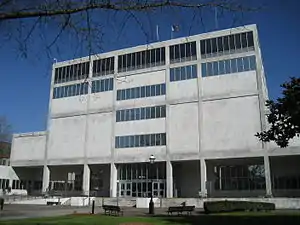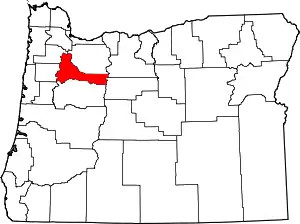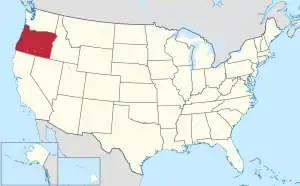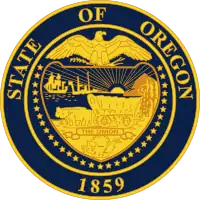Marion County, Oregon
Marion County is one of the 36 counties in the U.S. state of Oregon. The population was 315,335 at the 2010 census,[1] making it the fifth-most populous county in Oregon. The county seat is Salem,[2] which is also the state capital of Oregon. The county was originally named the Champooick District, after Champoeg (earlier Champooick[3]), a meeting place on the Willamette River. On September 3, 1849, the territorial legislature renamed it in honor of Francis Marion,[4] a Continental Army general from South Carolina who served in the American Revolutionary War.
Marion County | |
|---|---|
 Marion County Courthouse in Salem | |
 Location within the U.S. state of Oregon | |
 Oregon's location within the U.S. | |
| Coordinates: 44°55′N 122°35′W | |
| Country | |
| State | |
| Founded | July 5, 1843 |
| Seat | Salem |
| Largest city | Salem |
| Area | |
| • Total | 1,194 sq mi (3,090 km2) |
| • Land | 1,184 sq mi (3,070 km2) |
| • Water | 10 sq mi (30 km2) 0.85%% |
| Population (2010) | |
| • Total | 315,335 |
| • Estimate (2019) | 347,818 |
| • Density | 267/sq mi (103/km2) |
| Time zone | UTC−8 (Pacific) |
| • Summer (DST) | UTC−7 (PDT) |
| Congressional district | 5th |
| Website | www |
Marion County is part of the Salem, OR Metropolitan Statistical Area, which is also included in the Portland-Vancouver-Salem, OR-WA Combined Statistical Area. It is located in the Willamette Valley.
History
Marion County was created by the Provisional Legislature of Oregon on July 5, 1843 as the Champooick District, one of the original four districts of the Oregon Country along with Twality (later Washington), Clackamas, and Yamhill counties. The four districts were redesignated as counties in 1845.
Originally, this political entity stretched southward to the California border and eastward to the Rocky Mountains. With the creation of Wasco, Linn, Polk, and other counties, its area was reduced in size. Marion County's present geographical boundaries were established in 1856.
In 1849, Salem was designated the county seat. The territorial capital was moved from Oregon City to Salem in 1852. The ensuing controversy over the location of the capital was settled in 1864 when Salem was confirmed as the state capital.
Geography
According to the U.S. Census Bureau, the county has a total area of 1,193 square miles (3,090 km2), of which 1,182 square miles (3,060 km2) is land and 10 square miles (26 km2) (0.9%) is water.[5]
Adjacent counties
- Yamhill County (northwest)
- Clackamas County (north)
- Wasco County (northeast)
- Jefferson County (east)
- Linn County (south)
- Polk County (west)
National protected areas
Demographics
| Historical population | |||
|---|---|---|---|
| Census | Pop. | %± | |
| 1850 | 2,749 | — | |
| 1860 | 7,088 | 157.8% | |
| 1870 | 9,965 | 40.6% | |
| 1880 | 14,576 | 46.3% | |
| 1890 | 22,934 | 57.3% | |
| 1900 | 27,713 | 20.8% | |
| 1910 | 39,780 | 43.5% | |
| 1920 | 47,187 | 18.6% | |
| 1930 | 60,541 | 28.3% | |
| 1940 | 75,246 | 24.3% | |
| 1950 | 101,401 | 34.8% | |
| 1960 | 120,888 | 19.2% | |
| 1970 | 151,309 | 25.2% | |
| 1980 | 204,692 | 35.3% | |
| 1990 | 228,483 | 11.6% | |
| 2000 | 284,834 | 24.7% | |
| 2010 | 315,335 | 10.7% | |
| 2019 (est.) | 347,818 | [6] | 10.3% |
| U.S. Decennial Census[7] 1790-1960[8] 1900-1990[9] 1990-2000[10] 2010-2019[1] | |||
2000 census
As of the census of 2000,[11] there were 284,834 people, 101,641 households, and 70,437 families living in the county. The population density was 241 people per square mile (93/km2). There were 108,174 housing units at an average density of 91 per square mile (35/km2). The racial makeup of the county was 81.62% White, 0.89% Black or African American, 1.44% Native American, 1.75% Asian, 0.36% Pacific Islander, 10.58% from other races, and 3.35% from two or more races. 17.10% of the population were Hispanic or Latino of any race. 18.4% were of German, 9.2% English, 8.2% American and 7.4% Irish ancestry. 80.8% spoke English, 14.8% Spanish and 1.4% Russian as their first language.
There were 101,641 households, out of which 34.50% had children under the age of 18 living with them, 53.70% were married couples living together, 11.00% had a female householder with no husband present, and 30.70% were non-families. 24.00% of all households were made up of individuals, and 9.50% had someone living alone who was 65 years of age or older. The average household size was 2.70 and the average family size was 3.19.
In the county, the population was spread out, with 27.40% under the age of 18, 10.30% from 18 to 24, 28.70% from 25 to 44, 21.20% from 45 to 64, and 12.40% who were 65 years of age or older. The median age was 34 years. For every 100 females, there were 101.10 males. For every 100 females age 18 and over, there were 99.50 males.
The median income for a household in the county was $40,314, and the median income for a family was $46,202. Males had a median income of $33,841 versus $26,283 for females. The per capita income for the county was $18,408. About 9.60% of families and 13.50% of the population were below the poverty line, including 18.10% of those under age 18 and 7.40% of those age 65 or over.
2010 census
As of the 2010 United States Census, there were 315,335 people, 112,957 households, and 77,044 families living in the county.[12] The population density was 266.7 inhabitants per square mile (103.0/km2). There were 120,948 housing units at an average density of 102.3 per square mile (39.5/km2).[13] The racial makeup of the county was 78.2% white, 1.9% Asian, 1.6% American Indian, 1.1% black or African American, 0.7% Pacific islander, 12.6% from other races, and 3.9% from two or more races. Those of Hispanic or Latino origin made up 24.3% of the population.[12] In terms of ancestry, 22.1% were German, 11.4% were English, 11.0% were Irish, and 4.7% were American.[14]
Of the 112,957 households, 35.5% had children under the age of 18 living with them, 50.4% were married couples living together, 12.4% had a female householder with no husband present, 31.8% were non-families, and 25.0% of all households were made up of individuals. The average household size was 2.70 and the average family size was 3.23. The median age was 35.1 years.[12]
The median income for a household in the county was $46,069 and the median income for a family was $54,661. Males had a median income of $39,239 versus $32,288 for females. The per capita income for the county was $21,915. About 11.7% of families and 16.0% of the population were below the poverty line, including 23.8% of those under age 18 and 7.6% of those age 65 or over.[15]
Law and government
- Elected officials
Marion County is among the 24 of Oregon's 36 counties that operate under a board of commissioners (BOC) of three members elected countywide to 4-year terms. In Marion County these are partisan races. Commissioners, who are full-time, salaried officials, have executive, legislative, and quasi-judicial powers (the latter in land-use cases).[16] The Board of Commissioners serves as the governing body. The commissioners elect their chair annually; in practice, in Marion County the chair rotates annually. The BOC is responsible for accepting funds from sources outside the county, strategic planning, and enacting ordinances as needed to carry out plans and serve the public. The BOC also prepares a county budget in cooperation with the elected heads of the various departments. The BOC is required by law to appoint a Budget Officer who presents a budget to the Budget Committee composed of the Commissioners and three public members. County commissioners appoint and oversee non-elected department heads, officers, boards, and commissions.
In addition to the Board of Commissioners, the county has the following non-partisan positions that are elected in county-wide elections for four year terms: Assessor, Clerk, Treasurer, District Attorney, Sheriff, and Justices of the Peace. These officers are not accountable to the Board of Commissioners although they work with the commissioners in establishing a county budget. All are full-time, paid county officers.[16]
- County Commission (three commissioners)
- Commissioner: Kevin Cameron[17]
- Commissioner: Sam Brentano[18]
- Commissioner: Colm Willis[19]
- District Attorney: Paige Clarkson[20]
- Sheriff: Joe Kast[21]
- Assessor: Tom Rohlfing[22]
- Clerk: Bill Burgess[23]
- Treasurer: Laurie Steele[24]
- Justice of the Peace: Janice Zyryanoff[25]
- Military
Politics
Marion County is a historically Republican county that has become more competitive in the last 30 years. Although the Democrats won with pluralities in 1996, 2008, and 2020, no Democrat has carried a majority of the county since Lyndon Johnson in 1964.
Marion County is one of only twelve counties to have voted for Obama in 2008, Romney in 2012, Trump in 2016, and Biden in 2020, a pattern that was particularly evident elsewhere in the Mountain West.[lower-alpha 1]
| Year | Republican | Democratic | Third parties |
|---|---|---|---|
| 2020 | 47.7% 79,002 | 48.9% 80,872 | 3.4% 5,660 |
| 2016 | 46.3% 63,377 | 42.2% 57,788 | 11.5% 15,675 |
| 2012 | 50.0% 60,190 | 46.8% 56,376 | 3.2% 3,810 |
| 2008 | 47.4% 59,059 | 49.6% 61,816 | 3.0% 3,688 |
| 2004 | 53.9% 69,900 | 44.5% 57,671 | 1.6% 2,048 |
| 2000 | 50.7% 57,443 | 43.6% 49,430 | 5.7% 6,461 |
| 1996 | 43.2% 46,415 | 45.3% 48,637 | 11.6% 12,411 |
| 1992 | 38.2% 42,145 | 37.3% 41,137 | 24.5% 27,052 |
| 1988 | 51.2% 45,292 | 46.6% 41,193 | 2.3% 2,007 |
| 1984 | 59.8% 54,535 | 40.0% 36,440 | 0.3% 234 |
| 1980 | 49.4% 42,191 | 37.6% 32,134 | 13.0% 11,124 |
| 1976 | 49.1% 35,497 | 46.7% 33,781 | 4.2% 3,053 |
| 1972 | 57.5% 36,441 | 37.7% 23,908 | 4.8% 3,012 |
| 1968 | 54.8% 30,417 | 40.2% 22,327 | 5.0% 2,758 |
| 1964 | 36.9% 18,897 | 62.7% 32,091 | 0.4% 221 |
| 1960 | 58.3% 29,124 | 41.6% 20,791 | 0.1% 55 |
| 1956 | 64.2% 28,990 | 35.8% 16,170 | 0.0% 0 |
| 1952 | 70.4% 29,887 | 29.1% 12,337 | 0.5% 224 |
| 1948 | 57.3% 18,997 | 39.7% 13,183 | 3.0% 991 |
| 1944 | 56.6% 16,176 | 41.6% 11,907 | 1.8% 518 |
| 1940 | 54.3% 16,940 | 44.9% 14,031 | 0.8% 256 |
| 1936 | 33.0% 8,595 | 59.6% 15,536 | 7.4% 1,940 |
| 1932 | 39.0% 8,633 | 56.8% 12,572 | 4.2% 926 |
| 1928 | 62.0% 11,754 | 36.9% 6,998 | 1.2% 219 |
| 1924 | 52.1% 8,351 | 25.0% 3,996 | 22.9% 3,669 |
| 1920 | 66.2% 8,798 | 28.8% 3,831 | 5.0% 669 |
| 1916 | 55.5% 8,316 | 38.0% 5,699 | 6.5% 973 |
| 1912 | 31.2% 2,523 | 32.0% 2,588 | 36.8% 2,974[27] |
| 1908 | 57.2% 3,788 | 33.8% 2,239 | 8.9% 591 |
| 1904 | 70.0% 4,106 | 18.5% 1,084 | 11.5% 673 |
| 1900 | 54.3% 3,112 | 40.5% 2,318 | 5.1% 293 |
| 1896 | 50.9% 3,744 | 46.5% 3,419 | 2.4% 181 |
| 1892 | 49.7% 2,979 | 14.6% 879 | 35.5% 2,127 |
| 1888 | 54.0% 2,235 | 37.9% 1,567 | 8.0% 331 |
| 1884 | 56.0% 2,193 | 41.6% 1,627 | 2.3% 91 |
| 1880 | 59.2% 2,051 | 40.0% 1,386 | 0.7% 27 |
Economy
Agriculture and food processing are important to the county's economy, as are lumber, manufacturing, and education. Marion County is the leader in agricultural production among all other Oregon counties.[28] Marion County has 10,640 acres (43 km2) planted in orchards. The marionberry was named after the county. Government, however, is the county's main employer and economic base.
Education
Marion County is the home of Willamette University, Corban University, and Chemeketa Community College.[28]
Communities
Cities
Census-designated places
Unincorporated communities
Notes
- The other eleven are Butte County, California; Teton County, Idaho; Kendall County, Illinois; McLean County, Illinois; Tippecanoe County, Indiana; Kent County, Michigan; Leelanau County, Michigan; Carroll County, New Hampshire; Rockingham County, New Hampshire; Grand County, Utah; and Albany County, Wyoming.
References
- "State & County QuickFacts". United States Census Bureau. Archived from the original on June 20, 2011. Retrieved November 15, 2015.
- "Find a County". National Association of Counties. Retrieved June 7, 2011.
- Horner, John B. "Oregon: Her History, Her Great Men, Her Literature". Portland, Oregon: The J.K. Gill Co., 1919, p. 98.
- Gannett, Henry (1905). The Origin of Certain Place Names in the United States. U.S. Government Printing Office. p. 200.
- "2010 Census Gazetteer Files". United States Census Bureau. August 22, 2012. Retrieved February 26, 2015.
- "Population and Housing Unit Estimates". Retrieved March 26, 2020.
- "U.S. Decennial Census". United States Census Bureau. Retrieved February 26, 2015.
- "Historical Census Browser". University of Virginia Library. Retrieved February 26, 2015.
- Forstall, Richard L., ed. (March 27, 1995). "Population of Counties by Decennial Census: 1900 to 1990". United States Census Bureau. Retrieved February 26, 2015.
- "Census 2000 PHC-T-4. Ranking Tables for Counties: 1990 and 2000" (PDF). United States Census Bureau. April 2, 2001. Retrieved February 26, 2015.
- "U.S. Census website". United States Census Bureau. Retrieved January 31, 2008.
- "DP-1 Profile of General Population and Housing Characteristics: 2010 Demographic Profile Data". United States Census Bureau. Archived from the original on February 13, 2020. Retrieved February 23, 2016.
- "Population, Housing Units, Area, and Density: 2010 - County". United States Census Bureau. Archived from the original on February 13, 2020. Retrieved February 23, 2016.
- "DP02 SELECTED SOCIAL CHARACTERISTICS IN THE UNITED STATES – 2006-2010 American Community Survey 5-Year Estimates". United States Census Bureau. Archived from the original on February 13, 2020. Retrieved February 23, 2016.
- "DP03 SELECTED ECONOMIC CHARACTERISTICS – 2006-2010 American Community Survey 5-Year Estimates". United States Census Bureau. Archived from the original on February 13, 2020. Retrieved February 23, 2016.
- "County Government in Marion and Polk Counties (2005) - LWV of Marion and Polk Counties". marionpolk.or.lwvnet.org. Retrieved 2020-06-03.
- Poehler, Bill. "Election results: Republicans appear to retain Marion County Commissioner races". Statesman Journal. Retrieved 2020-06-03.
- "Sam Brentano won't seek re-election in 2020". Salem Reporter. 2019-10-30. Retrieved 2020-06-03.
- Poehler, Bill. "Marion County Commissioner accused of discrimination for trying to end transgender program". Statesman Journal. Retrieved 2020-06-03.
- Woodworth, Whitney. "Paige Clarkson takes over Marion County DA job early as Walt Beglau leaves office". Statesman Journal. Retrieved 2020-06-03.
- "Sheriff's Office". www.co.marion.or.us. Retrieved 2020-06-03.
- "Assessor's Office". www.co.marion.or.us. Retrieved 2020-06-03.
- "Clerk's Office". www.co.marion.or.us. Retrieved 2020-06-03.
- "Treasurer's Office". www.co.marion.or.us. Retrieved 2020-06-03.
- "Justice Court". www.co.marion.or.us. Retrieved 2020-06-03.
- Leip, David. "Dave Leip's Atlas of U.S. Presidential Elections". uselectionatlas.org. Retrieved April 11, 2018.
- The leading "other" candidate, Progressive Theodore Roosevelt, received 1,919 votes, while Socialist Eugene Debs received 580 votes, Prohibition candidate Eugene Chafin received 475 votes.
- "Marion County, Oregon".
Further reading
- H.O. Lang (ed.), History of the Willamette Valley: Being a Description of the Valley and its Resources, with an Account of its Discovery and Settlement by White Men, and its Subsequent History; Together with Personal Reminiscences of its Early Pioneers. Portland: Himes and Lang, 1885.
- Portrait and Biographical Record of the Willamette Valley, Oregon, Containing Original Sketches of Many Well Known Citizens of the Past and Present. Chicago: Chapman Publishing Co., 1903.
- Marion County Historical Society, Marion County History. (periodical)
